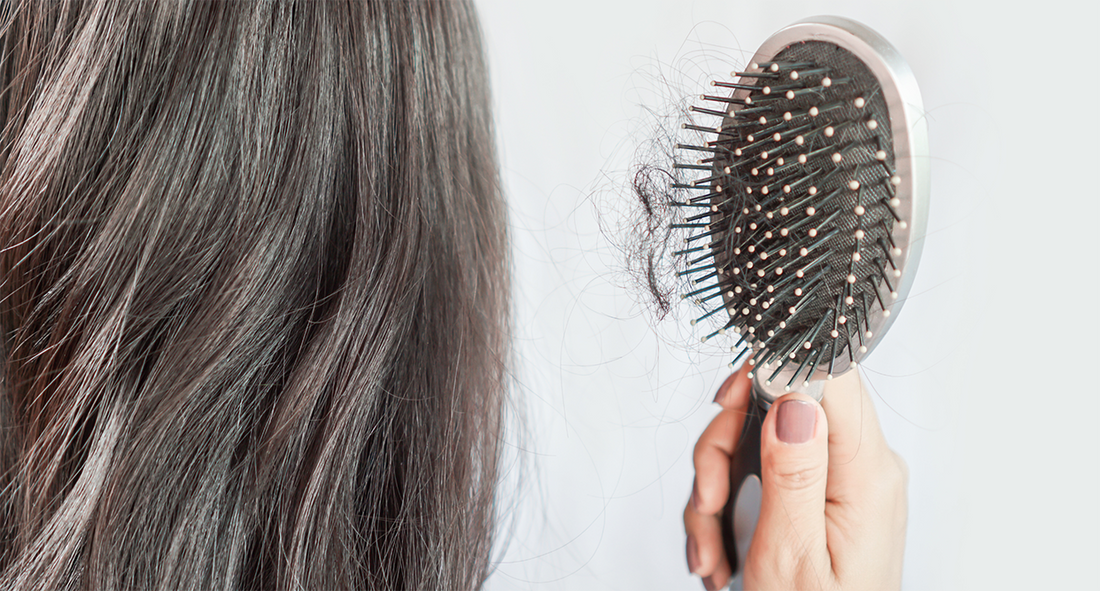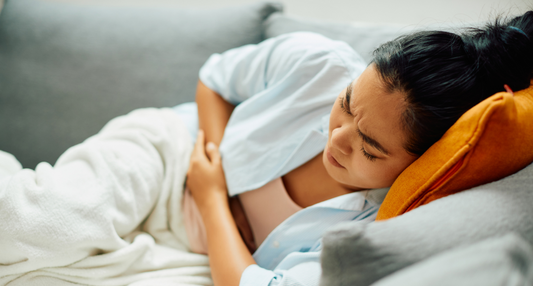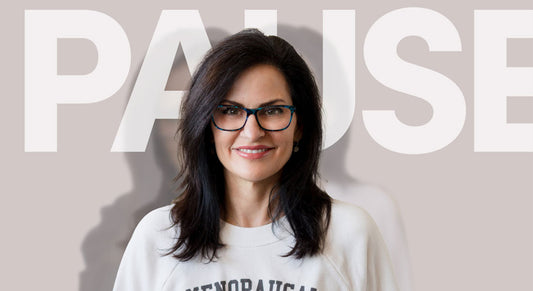Losing Hair During Menopause? Here’s What to do Next

Share
Shedding up to 100 hairs a day is considered normal, but you’re likely here because you may be noticing more hair in the shower drain than usual.
Losing your hair is shocking. As women, many of us spend time trying to remove hair from certain parts of our bodies. Then suddenly, we notice we are losing hair from places we want it. Almost everyone experiences hair loss, but it’s especially hard for women. No one batted an eye when my husband began balding in his 20s, but when I noticed changes in my hair growth, I felt like my femininity was falling out with my follicles.
Hair loss can have a heavy emotional and social impact. Luckily, there are existing and emerging treatments available to help.
Let’s discuss why hair loss can happen.
Why am I Losing my Hair During Menopause?
Menopause is commonly associated with changes in hair, including thinning, loss of volume, and altered texture. The primary driver of hair loss during menopause is the decline in estrogen levels, but the extent and patter of hair loss can vary widely among women.
The drop in estrogen during menopause affects the hair follicle lifecycle, leading to reduced hair growth, thinning, and changes in hair texture. Androgens (commonly referred to as male hormones) may also play a role, especially when estrogen levels fall, potentially resulting in female pattern hair loss or androgenic alopecia. This affects ⅓ of women, evidenced by thinning at the crown and top of the head.1 Most cases are mild, but severity can vary.
Why Do Hormones Affect Hair Loss?
All women have certain distributions of male and female sex hormones. The androgen hormone, also known as the male sex hormone, influences our scalp’s environment and the amount of time it holds onto its hair.
In earlier stages of life, our liver produces a binding hormone called globulin that keeps our androgen hormones from flowing throughout our blood stream. After menopause, the liver stops producing globulin and androgen hormones run wild – this is why we see an uptick in belly fat, new chin hairs, a sudden onset of acne and some menstrual irregularities, and of course, male-pattern hair growth and loss.
During this period, the size of our hair follicles become smaller, and we shed hair faster than we can grow it back. Two patterns are observed; one affecting the whole scalp (diffuse generalized hair loss) and the other results in hairline recession (frontal hair loss). Both may be accompanied by increased facial hair growth.
The Four Cycles of Hair Growth
Our normal hair growth experiences four different cycles. When under stress, our bodies change the normal duration of each cycle, which results in hair loss.
1. Growing Phase (Anagen):Anagen is the longest phase and lasts from two to seven years. When we’re healthy or young, almost all of our hair is in this phase.
2. Transition Phase (Catagen):The catagen phase, which lasts about three weeks, involves the hair shaft disconnecting from the area and chemicals from which it grows.
3: Resting Phase (Telogen):The telogen phase can also be referred to as the resting stage, where the hair does not grow but stays attached to the follicle. This phase can last about three months and represents 10-15% of hair at any given time.
4: Shedding Phase (Exogen):This phase lasts about two to five months. We release old hair and new begins to grow.
During telogenic effluvium we’re stressed.2 Our body wants us to rest, so the majority of our hair follicles shift energy from the growing phase to the resting phase. As a result, our hair becomes thinner and sparser.
Factors Influencing Hair Loss
Stress
If you’re experiencing a period of intense physical, mental or emotional stress, you may begin to shed a startling amount of hair. This is a disorder known as telogenic effluvium.3 The clinical term sounds scary, but it is a nonpermanent condition and usually subsides 3 -4 months after the stressor is lifted.
Pregnancy and Hair Loss
Despite all those pre and postnatal vitamins, 40-50% of women experience significant hair loss about three to four months after delivering their child.4If not caused by a nutrient deficiency, this change is temporary and hair follicles should rejuvenate and kick into gear around six to 12 months after baby arrives.
Hypothyroidism
Have you had your thyroid hormones checked? Although rare, an under or overactive thyroid could be causing your hair loss.
The thyroid gland affects the function of the metabolism, digestion, heart and bone health, to name a few. Nutrient deficiencies and nervous system dysfunction are common without the correct hormone production – this affects the cycles of hair growth.
If you’re experiencing a combination of significant fatigue, brain fog, racing heart or palpitations, slow or aggravated digestion, memory impairment or jitters, you may want to have your doctor check on your thyroid stimulating hormone levels.
Nutritional Deficiencies
Try as we might to eat a healthy, balanced diet, sometimes our body lacks specific nutrients that contribute to cellular growth and hair follicle strength. If your body lacks nutrients like zinc and iron, it may inhibit your hair growth.
Screening for deficiencies in vitamin A, vitamin B, vitamin C, vitamin D, vitamin E, iron, selenium, and zinc may help to ascertain the culprit of your hair loss problem. Keep in mind that taking huge super doses of these and minerals will not make your hair grow like weeds unless you’re deficient in those specific nutrients.5
Alopecia Areata
This is an autoimmune condition in which the body’s immune system attacks the hair follicles.6You may experience smooth, round bald patches or even total baldness. This isn’t permanent but may recur without treatment. If you are diagnosed, steroids may be available to treat your condition.
Fungal infections
There are a few fungal infections that may cause hair loss, such as:
- Ringworm, a rash on the scalp and inside the hair shaft.
- Folliculitis, an infection of the hair follicle, the little space where the hair lives.
- Seborrheic Dermatitis, a yeast that appears on oily parts of the body like the scalp.
- Piedra, which leaves pearl-like deposits on the hair shaft.7
Talk to your doctor if you experience itching, redness, scaliness or strange sediment along your scalp.
High Ponytails/Tight Hair Accouterments
Pulling hair back tightly or brushing too fervently can lead to hair breakage. Do you notice your scalp looks tented when pulled back by your scrunchie? You may want to consider loosening your hair tying to prevent excess shedding.8
Treatments for Hair Loss
Minoxidil
Minoxidil is a well-established, FDA-approved treatment for female pattern hair loss and has shown significant effectiveness in increasing hair density and reducing shedding in menopausal women. Originally prescribed for high blood pressure, patients noticed their hair returning as an unanticipated side effect, and doctors realized the drug had more to offer.It widens blood vessels and makes it easier for your follicles to receive nutrients, which promotes a longer growth phase for your hair.
Minoxidil is available in liquid form over the counter, or in oral pill form prescribed by a clinician. Either way, it is not a quick fix. I know that waiting for hair to grow can feel like watching a plant grow from seedling to full fruit! The results can take three to six months to manifest, so try to be patient if you try this medication.9, 10
Finasteride
Oral finasteride is a effective and safe for postmenopausal women. Originally prescribed as an incontinence medication, it turns out it also treats gradual thinning of the hair on the scalp that leads to a receding hairline or balding on the top of the head.
Topical finasteride, particularly when combined with minoxidil, has demonstrated superior results in increasing hair diameter and density to compared to minoxidil alone, with minimal side effects.
Again, this takes about six months to see an effect.9, 10
Hormone and Other Therapies
Estrogen and progesterone therapies may have a role, but evidence is limited and results are inconsistent. Hormonal imbalances, particularly androgen excess and estrogen deficiency are key contributors to menopausal hair loss.11
Hormone replacement therapy is not recommended solely for the treatment of hair loss but other treatments including topical therapies and emerging peptide complexes may help to improve hair density and growth.12
Nutraceutical and Non-Phamacological Options
Long-term use of specific nutraceutical supplements (such as those containing phytoactives) has been shown in randomized controlled trials to significantly improve hair growth, reduce shedding, and enhance hair quality in perimenopausal and postmenopausal women. These supplements also positively impact quality of life and menopausal symptoms.13
New peptide complexes have been found to stimulate hair follicles, increasing hair density by promoting the transition from the resting to the growth phase.12
Microneedling
There’s evidence that microneedling can help with symptoms of androgenic alopecia and telogenic effluvium.Read more about this preliminary study here.14
You Have Options To Consider
The best-supported treatments for menopausal hair loss are topical minoxidil, oral or topical finasteride (especially in combination), and certain nutraceutical supplements. These options are effective in improving hair density, thickness, and reducing shedding, with combination therapies often providing the greatest benefit. Peptide complexes and hormonal therapies may also help, but more research is needed for these approaches.
Following a lifestyle to support a normal inflammatory response, including the Galveston Diet, may help youfeed your body the healthy fat and other vital nutrients needed to support hair growth and overall wellbeing.
When it comes to reversing hair loss, there is no one solution -- you have options to consider. Early recognition and tailored management can help, and you don’t have to go it alone. Speak with your healthcare provider about your concerns to find a treatment path that’s right for you.
This article contains affiliate links.























